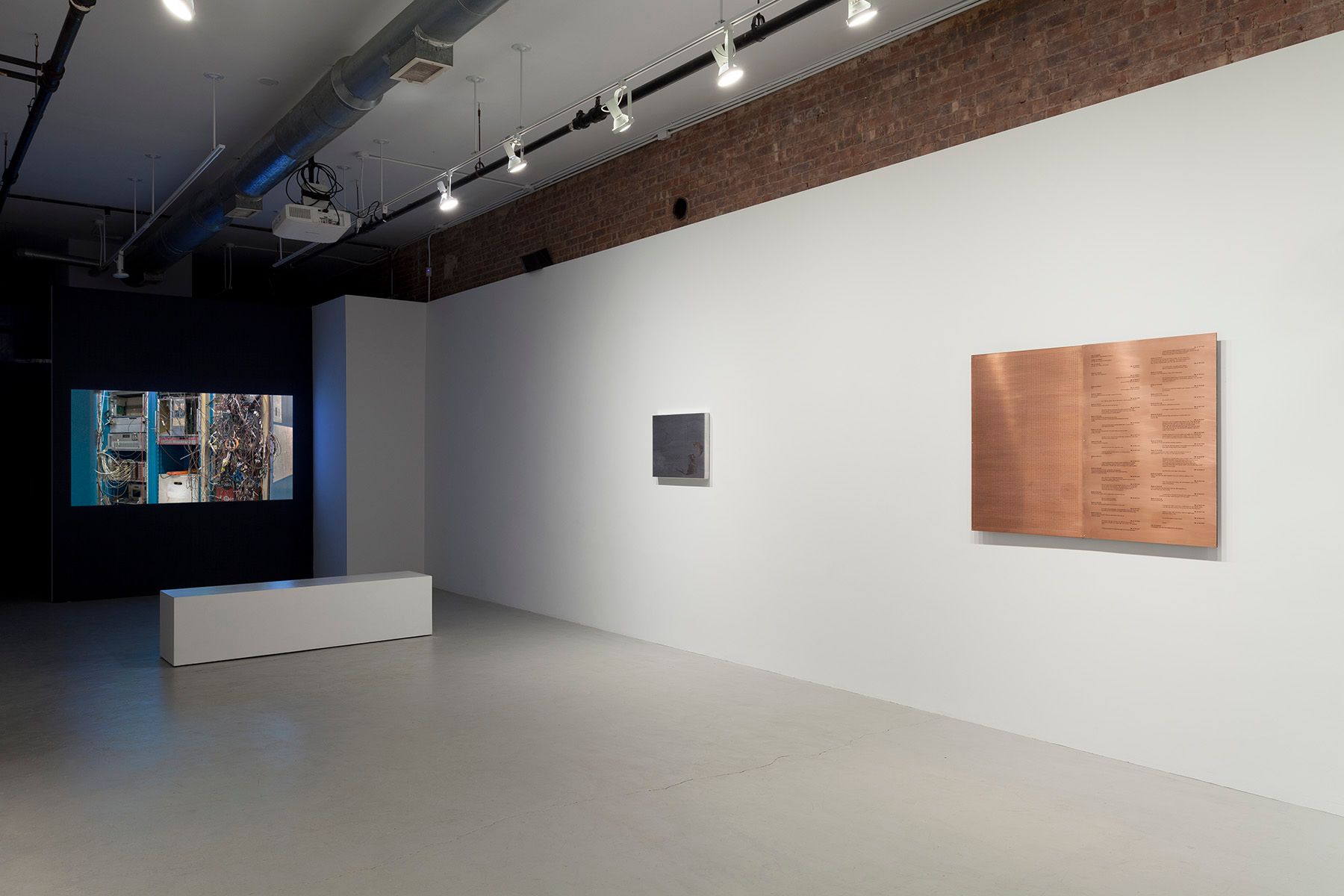Frank Heath’s Backup continues his interventions into systems of communication and the intended and unintended ways in which they short circuit. Signals and loops, missives to the future, and existential questions combined with serendipitous encounters are at the heart of the six laser-cut plaques and the two-channel video on view. These humorous, at times melancholic, works are highly self-referential and often include the correspondence from the process of making the plaque itself (live-help online chats/production drawings). As with Heath’s previous projects, he incorporates the voices of unsuspecting individuals into the work in a compassionate but subversive way. By co-opting mundane social exchanges and infusing them with an unexpected narrative, Heath’s impositions exist simultaneously in both private and public spheres.
Live Help Backup Plaque (Pioneer TX-9100 Schematic JPEG) (2014) shows in one of two engraved copper plates the code for a jpeg of the schematic from a 1973 Pioneer TX-9100 audio receiver. The corresponding panel records Heath’s live chat conversation with the company who produced the piece. The dialogue verges on the absurd, and yet ideas such as the tension between the analog and the digital emerge. The back and forth between Heath and “David” mirrors the depicted code, creating a loop that connects metonymically to other works on view, like Letter From Future Self (2014). This letter-sized brass plaque was made in duplicate, with one version in the gallery and the other mailed to the junior high school he attended. The plaque’s text revolves around a “letter to his future self” Heath and his classmates were instructed to write, and were to receive upon graduating from high school. Heath never received his letter and seeks to close the unrealized loop.
Questions of permanence of information, immateriality of technology, and extreme projections of the future—underlining currents in the plaques—provide the starting point for the video On The Beach(2014). This is the first of a seven episode series to be published throughout the following year in the online magazine Triple Canopy. The series, loosely adapted from the post-apocalyptic novel by Nevil Shute, depicts the construction of an urgent last-minute historical film project where interviews with specialists in a variety of fields provide prompts for a film crew who attempt to realize this suggested footage. The first episode (on view in the gallery) focuses on an interview with two physicists from CERN, home to the Large Hadron Collider. The scenes in which the scientists discuss their desire to learn about the origins of matter as well as possible transmissions to the future are blended together with scenes of the film crew attempting to assemble material for a kind of time capsule or ark that will record for a post-human future aspect of our civilization.
Frank Heath was born in 1982 in St. Joseph, MO. He lives and works in New York. Solo exhibitions, and two-person shows include: Asymptomatic Carrier, (solo) Frieze Frame with Simone Subal Gallery, NY, NY (2013); Post Holes (solo), Simone Subal Gallery, NY, NY (2012); Bcc: (with Brendan Meara), Roots and Culture, Chicago, IL, USA (2011); and Econoline 1, (with JJ PEET) Videotage Gallery, Hong Kong, China (2007). Past and upcoming group shows and screenings include: The Built Environment: Lower Side in Istanbul, Mixer, Istanbul, Turkey (2014); It Narratives: The Movement of Objects as Information, Franklin Street Works, Stamford, CT, USA (2014); A Tale of Two Islands: Beatrice Gibson with Alex Waterman, and Frank Heath, High Line Art, NY, NY (2014); Two Hours Two Minutes, The Power Plant, Toronto, Canada (2014); Kool-Aid Wino, Franklin Street Works, Stamford, CT, USA (2013); Matter Out of Place, Kitchen, NY, NY (2012); Somebody has stolen our tent, Simon Preston Gallery, NY, NY (2012); The Way Things Go (Part 3), Frutta, Rome, Italy (2012); Single Channel, Soho House, Miami, FL, USA (2011); Forcemeat, Wallspace, NY, NY (2011), and Suddenly: Where We Live Now, Cooley Gallery – Reed College, Portland, OR and Pomona College Museum of Art (2008, 2009).














































































































